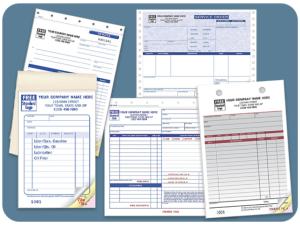
In today's fast-paced business environment, efficiency and accuracy are paramount. One tool that has revolutionized the way organizations streamline their documentation processes is carbonless forms. These versatile and efficient forms have gained popularity across various industries, offering a reliable alternative to traditional carbon paper. In this article, we will explore what carbonless forms are, how they work, the differences between carbon and carbonless paper, the process of creating carbonless forms, and the industries that benefit from their use.

What are carbonless forms?
Carbonless forms, also known as NCR (No Carbon Required) forms, are multipart business forms that eliminate the need for carbon paper. They consist of multiple layers, typically two to four, with each layer having a chemical coating on one side. When pressure is applied to the top layer, such as writing or printing, the pressure-sensitive coating reacts with the coating on the layer beneath it, creating a permanent mark without the use of carbon paper. They are used to create business receipt books, invoices, and other customized forms.
The difference between carbon and carbonless paper:
Carbon paper, which was widely used in the past, involves placing a sheet of carbon paper between two sheets of regular paper. When pressure is applied to the top sheet, the carbon layer transfers the mark onto the bottom sheet. This process can be messy, as the carbon coating tends to smudge and stain.
In contrast, carbonless paper eliminates the need for separate carbon sheets. The chemical coatings on each layer react to create a copy of the mark without the need for messy carbon transfer. This makes carbonless forms more convenient, cleaner, and easier to use.
How do carbonless forms work?
The working principle of carbonless forms is based on a microencapsulated dye system. Each layer of the form contains tiny microcapsules filled with colorless dye precursors. The topmost layer is coated with a clay-based coating that contains a developer chemical.
When pressure is applied, the microcapsules rupture, releasing the dye precursors. The developer chemical on the layer beneath reacts with the dye precursors, causing them to undergo a color-forming reaction. As a result, the mark made on the top sheet is replicated on the subsequent layers, creating multiple copies without the need for carbon paper.
What does carbonless paper mean?
Carbonless paper refers to a type of paper that is specially coated to create copies without the use of carbon paper. The paper has a chemical coating on one side, which reacts with pressure to transfer marks or images onto subsequent layers. The term "carbonless" emphasizes the fact that this paper eliminates the need for carbon sheets, offering a more efficient and environmentally friendly solution.
How to make carbonless forms:
Creating carbonless forms involves a specialized printing process. The base sheet, which is usually the topmost layer, is first printed with the desired content. The subsequent sheets, known as "plies," are then printed on the reverse side. The printing ink contains the necessary chemicals for the reaction to occur when pressure is applied.
Once the printing process is complete, the sheets are collated and glued together to form a cohesive multipart form. The final product is then trimmed to the desired size, ready for use.
Can I print my own carbonless forms?
Yes, it is possible to print your own carbonless forms, provided you have access to the necessary equipment and supplies. However, it is crucial to ensure that the printing process adheres to the specific requirements of carbonless paper. This includes using compatible inks, appropriate pressure settings, and ensuring proper registration between the different layers.
If you have frequent or large-scale printing needs, it may be more efficient to outsource the printing to professional printing companies that specialize in carbonless form production. These companies have the expertise, equipment, and quality control measures in place to ensure accurate and consistent results.
Carbonless forms have found applications in various industries due to their efficiency and convenience. Some of the industries that benefit from the use of carbonless forms include:
a) Retail: Retail businesses often use carbonless forms for sales receipts, order forms, and invoices. This allows for quick and accurate record-keeping and provides customers with a copy of their transactions.
b) Logistics and Warehousing: Carbonless forms are widely used in logistics and warehousing operations for packing slips, delivery orders, and inventory documentation. This enables efficient tracking of shipments, inventory management, and proof of delivery.
c) Healthcare: Medical facilities utilize carbonless forms for patient intake forms, medical records, prescriptions, and laboratory reports. The ability to produce multiple copies simultaneously simplifies record-keeping and ensures accurate documentation.
d) Service Industry: Service-oriented businesses such as repair shops, maintenance companies, and professional services often utilize carbonless forms for work orders, service contracts, and estimates. This helps maintain a systematic record of services provided and facilitates effective communication with customers.
e) Banking and Finance: Banks, credit unions, and financial institutions rely on carbonless forms for deposit slips, loan applications, transaction receipts, and account statements. The duplication of documents ensures accurate financial records and enhances customer service.
f) Education: Educational institutions use carbonless forms for various purposes, including permission slips, progress reports, attendance sheets, and school forms. This simplifies administrative processes and provides a clear paper trail for documentation.
Carbonless forms have revolutionized the way businesses handle documentation, offering a cleaner, more efficient, and environmentally friendly alternative to traditional carbon paper. With their ability to produce multiple copies simultaneously, carbonless forms streamline record-keeping processes and improve accuracy across various industries. Whether it's in retail, logistics, healthcare, the service industry, banking, finance, or education, the versatility and benefits of carbonless forms make them indispensable tool for efficient documentation. By eliminating the need for carbon paper, carbonless forms contribute to a more streamlined and sustainable approach to business operations.
Posted on June 26, 2023